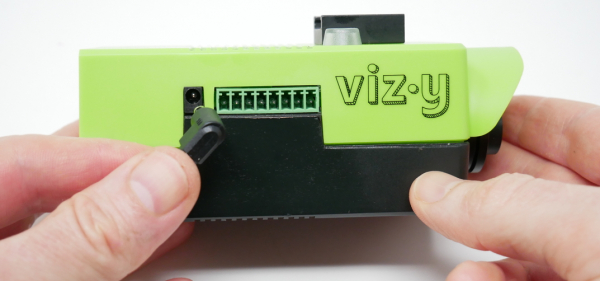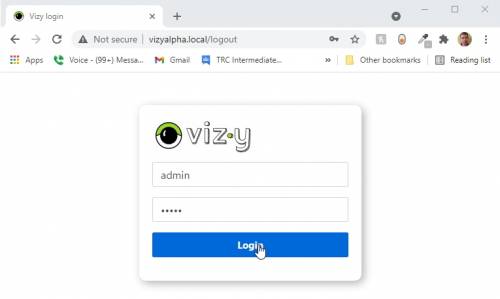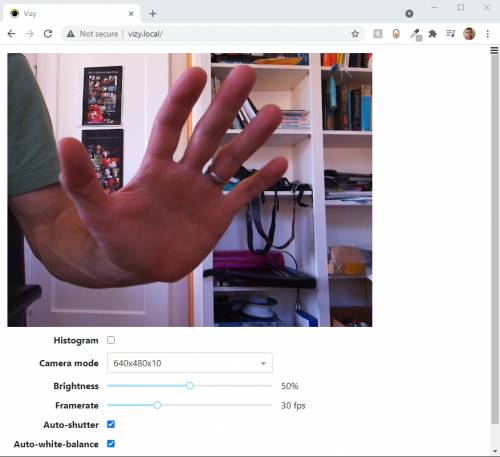This is an old revision of the document!
Table of Contents
Getting started with your Vizy camera
Start by plugging the Vizy power adapter into your Vizy.
Note: check that you're plugging the power cord into the logo side of Vizy, as shown below.
Plug the other end of your power adapter into an AC outlet. Vizy's power supply has US plugs, but can handle up to 240V, so it will work with European voltages. IF you're outside the US, only a simple AC connector adapter is required – no step-down voltage converter/transformer is necessary.
Turn your Vizy on by pressing the button on your Vizy. Just press and release – don't press and hold down.
When Vizy turns on it will beep and begin to initialize. The button will change colors several times, eventually settling on a soothing light blue after about 45 seconds or so.
Vizy is now ready to accept connections.
Connecting to your Vizy
You interact with Vizy using a standard web browser running on your computer, laptop, or phone, but in order to do so, your computer, laptop, or phone needs a network connection to Vizy. You have some choices when connecting to your Vizy. Choose one of three options below.
Connect to your Vizy via wired Ethernet (100BASE-T, 1000BASE-T)
This is probably the simplest option, but it requires a wired network and a network cable. Just connect your Vizy to a BASE-T connector and it should self-configure (assuming your network has a DHCP server, which is usually the case.)
Connect to Vizy directly over WiFi (WiFi Access Point Mode)
Vizy will become a WiFi Access Point (AP) upon initialization until you configure it differently. In AP mode, you can connect to Vizy directly. Bring up your computer/laptop/phone's WiFi network selector and look for a network named vizy-xxxx where xxxx is a semi-unique 4-digit number. Go ahead and select the vizy-xxxx network.
The password/security key for the network is 12345678. (Note, this is not the same as the PIN, which some network devices support.)
Have Vizy connect to your WiFi network (WiFi Network Mode)
This requires some extra configuration steps. Since this is the Quick Start guide, we suggest configuring this later, but you're welcome to do so now if you wish.
Once you've connected to Vizy...
Once you are connected to your Vizy via one of the possible methods above, you can point your browser to http://vizy.local to see what your Vizy is up to. When you first visit Vizy, you'll be presented with a login screen:
Use admin and admin for Username and Password and click on Login
Note, if you are using Windows and you don't see video in your browser (as in the picture above) early versions of Vizy's software (Version 0.0.75 and earlier) had issues with streaming video to browsers running in Windows and some Linux's when connecting to Vizy in access point mode. If you notice this behavior, please update your Vizy software to the latest version.
Safari MacOS
If you are using Safari in MacOS, you will need to enable WebRTC.
Running apps
When Vizy initializes, it runs a default application (app). You can configure Vizy to run a different app upon initialization, and you can run any of the available apps at any time by bringing up the Apps/examples dialog.
Note, as of software version 0.0.82, only the birdfeeder app is available. We are working hard to release more apps as soon as possible!
In the meantime, we also have several simple examples that can be run. Select the example you're interested in running with the Run example dropdown menu and press Run to the right of the selection. The example will then be run. You can explore the different example programs this way.
Here are the available examples as of version 0.0.82:
- edge_detection: Simple example of using OpenCV with Vizy.
- tensorflow: Demonstration of full Tensorflow with the COCO dataset.
- tflite: Demonstration of Tensorflor Lite with the COCO dataset.
- video: Simple example of video streaming and adjusting camera parameters.
The example source code is written in Python and can found in ~/vizy/examples on Vizy's filesystem.
Next steps
Depending on how you would like to use your Vizy, here are some next steps:










